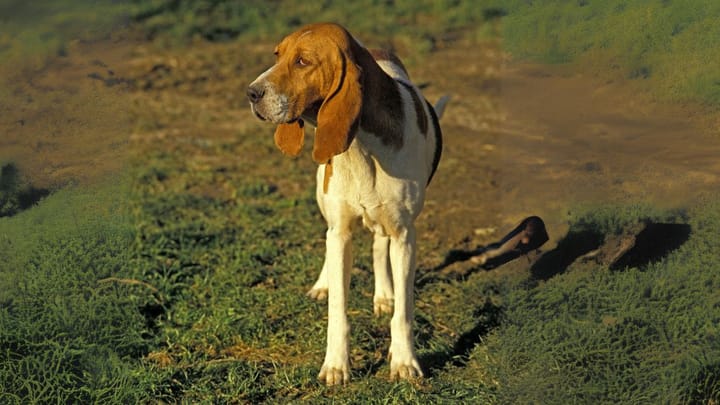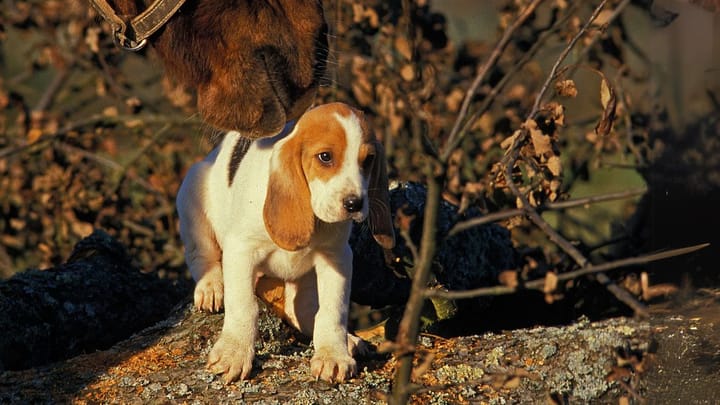Artois Hound
Other names : Chien d’Artois, Picard, Briquet


Formerly known as the Picard, the Artois Hound has been in existence for over 500 years. It’s believed to have been developed from the English Beagle and was used as a hunting dog by members of the French aristocracy. Unsurprisingly, the Artois Hound has an excellent nose, first-class tracking skills, and lots of stamina. They’re happiest when working, but can still make excellent pets.This is a friendly, affectionate, and loyal animal.
|
Life expectancy |
The Artois Hound has a life expectancy of between 11 and 13 years |
|
Temperament |
|
|
Size |
Medium
|
|
Adult size |
Female
Between 21 and 23 in
Male
Between 21 and 23 in
|
|
Adult weight |
Female
Between 62 and 66 lb
Male
Between 62 and 66 lb
|
|
Coat colour
Tri-colour. Black, white, and fawn. |
Black White Brown |
|
Type of coat
Short. Flat. Rough. Close to the body. |
Short |
|
Eye colour
Deep brown. |
Brown
|
|
Purchase price |
The Artois Hound costs between £1000 and £1200 |
It’s advised to check their ears on a regular basis. They also need a monthly clean. Any breeds with long, pendulous ears are prone to ear infections.
Physical exercise is not enough for these dogs. They also need a mental challenge. This is a task-driven breed with a very strong work ethic.
More details about the Artois Hound
Artois Hound: Origins and history
The breed was developed in France around 500 years ago and reached its peak during the 17th century, when it was a dog of choice for the French Nobility. For hundreds of years it worked alongside hunters, tracking rabbits, foxes, and boars. Its numbers remained relatively high until after the second world war. The effects of the war on France, as well as growing industrialisation, forced the breed to the brink of extinction. It was saved by a French breeder named Mr. B Audrechy. After hearing of the Artois Hound’s decline, he located the remaining dogs and set up a breeding programme. The Artois Hound club now has over 500 dogs registered in its stud book and the breed’s overall numbers are on the rise.
Physical characteristics of the Artois Hound
Medium sized, well-constructed dog with quite a long body. Short, sturdy legs. Long, thin tail and large, pendulous ears. A warm and friendly expression.
FCI classification of the Artois Hound
-
Group 6 - Scent hounds and related breeds
-
Section 1 : Scent hounds
Artois Hound: Characteristics
Artois Hound: Behaviour
Training a Artois Hound
Training the Artois requires patience, experience, and some creativity. This dog will quickly grow bored of the basic obedience commands. They need to be consistently challenged and praised.
Artois Hound: Lifestyle
Breed compatibility Artois Hound
Artois Hound: Purchase price
The initial cost of a Artois Hound puppy is between £1,000 to £1,200. The average cost to keep one of these dogs (including vet bills, insurance, and food) is between £80 to £85 a month.
Artois Hound: Grooming
Thanks to its very short coat, the Artois Hound has minimal grooming requirements. Very easy to maintain.
Artois Hound: Health
A very healthy and well-bred dog. Its average life expectancy is between 11 and 13 years.
A well-balanced, muscular dog. Not the strongest, but still very robust. Comfortable tracking its prey across rugged terrain.
No issues when its comes to dealing with heat. The Artois Hound has a short, close fitting coat that prevents them from overheating.
Not built for the cold. Will need a doggy coat if temperatures suddenly plummet.
No issues with unexplained weight gain or obesity. An active dog with a naturally lean frame.


